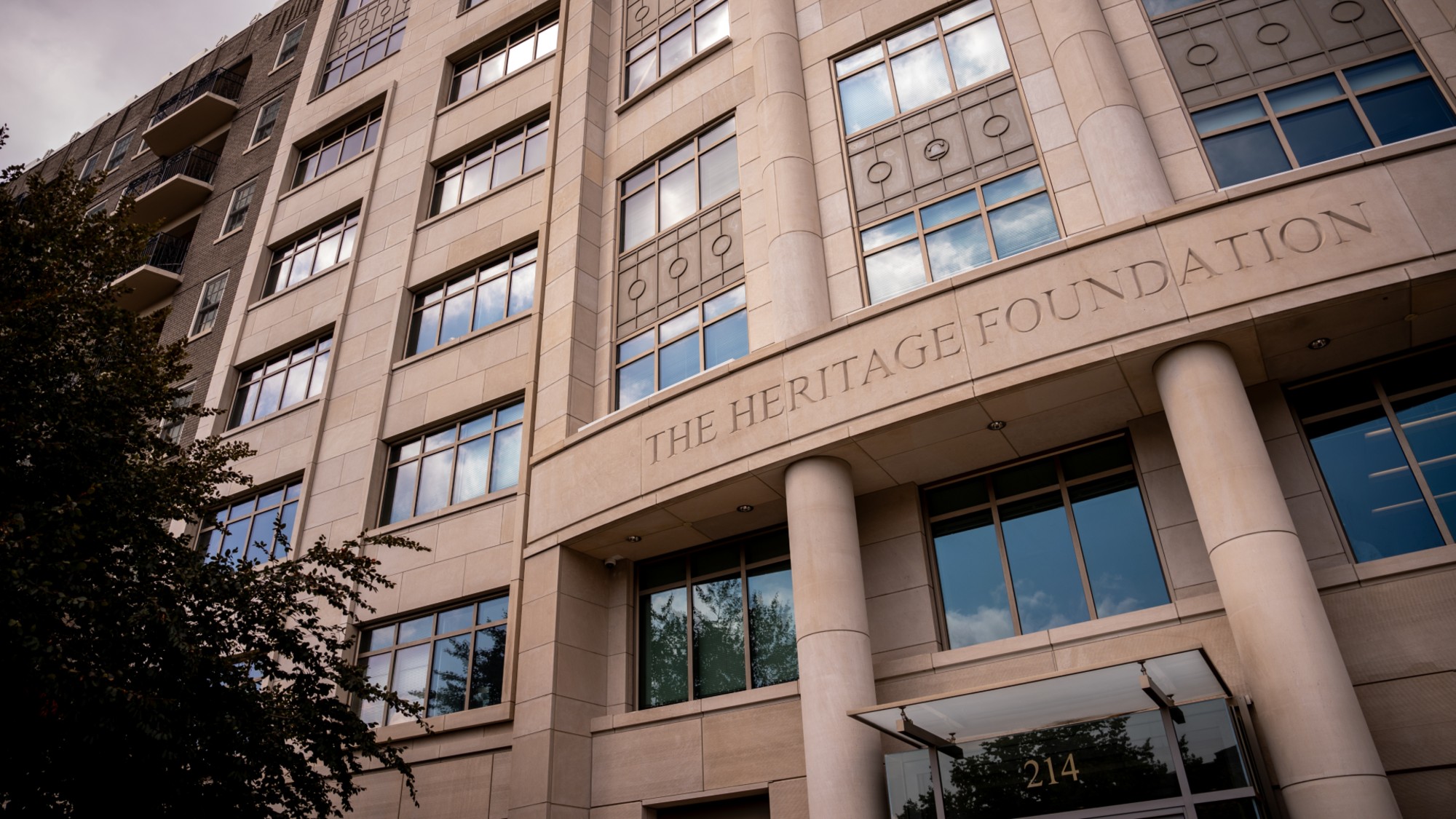The last word: America’s Stonehenge
A mammoth monument that sits on a rural Georgia hilltop contains instructions for survivors of the apocalypse, says Wired magazine’s Randall Sullivan. Who would build such a thing?
A mammoth monument that sits on a rural Georgia hilltop contains instructions for survivors of the apocalypse, says Wired magazine’s Randall Sullivan. Who would build such a thing?
The strangest monument in America looms over a barren knoll in northeastern Georgia. Five massive slabs of polished granite rise out of the earth in a star pattern, topped at a height of 16 feet by a 25,000-pound capstone. Built in 1980, this pale gray edifice, which instantly evokes England’s Stonehenge, is quietly awaiting the end of the world as we know it.
Called the Georgia Guidestones, the monument is a mystery—nobody knows exactly who commissioned it or why. The only clues to its origin are on a nearby plaque and the “guides” themselves, directives carved into the rocks. These instructions appear in eight languages and reflect a peculiar New Age ideology.
The Week
Escape your echo chamber. Get the facts behind the news, plus analysis from multiple perspectives.

Sign up for The Week's Free Newsletters
From our morning news briefing to a weekly Good News Newsletter, get the best of The Week delivered directly to your inbox.
From our morning news briefing to a weekly Good News Newsletter, get the best of The Week delivered directly to your inbox.
What’s most widely agreed upon—based on the evidence available—is that the Guidestones are meant to instruct the dazed survivors of some impending apocalypse as they attempt to reconstitute civilization. Not everyone is comfortable with this notion. A few days before I visited recently, the stones had been splattered with polyurethane and spray-painted with graffiti, including slogans like “Death to the new world order.” This defacement was the first serious act of vandalism in the Guidestones’ history, but it was hardly the first objection to their existence. In fact, for more than three decades this uncanny structure has been generating responses that range from enchantment to horror.
Supporters (notable among them Yoko Ono) have praised the messages as a stirring call to rational thinking. Opponents have attacked them as the Ten Commandments of the Antichrist.
Whoever the anonymous architects of the Guidestones were, they clearly knew that people prize what they don’t understand.
The story of the Georgia Guidestones began on a Friday afternoon in June 1979, when a gray-haired gentleman showed up in Elbert County, made his way to the offices of Elberton Granite Finishing, and introduced himself as Robert C. Christian. He claimed to represent “a small group of loyal Americans” who had been planning the installation of an unusually large stone monument. Christian had come to Elberton, he said, because he believed its quarries produced the finest stone on the planet.
A free daily email with the biggest news stories of the day – and the best features from TheWeek.com
Joe Fendley, Elberton Granite’s president, nodded absently at first, distracted by the rush to complete that week’s payroll. But when Christian began to describe the scale and precision required of the monument he had in mind, Fendley stopped what he was doing.
What in the world would it be for? Fendley asked. Christian explained that the structure he had in mind would serve as a compass, calendar, and clock. It would also need to be engraved with a set of guides written in eight of the world’s major languages. And it had to be capable of withstanding the most catastrophic events, so that the shattered remnants of humanity would be able to use those guides to re-establish a better civilization than the one that had just been destroyed.
Fendley is now deceased, but shortly after the Guidestones went up, an Atlanta television reporter asked what he was thinking when he first heard Christian’s plan. “I was thinking, I got a nut in here now. How am I going to get him out?” Fendley said. He attempted to discourage the man by quoting him a price several times higher than for any project commissioned there before. But Christian merely nodded and asked how long it would take. Fendley didn’t rightly know—six months, at least. He wouldn’t be able to even consider such an undertaking, he added, until he knew it could be paid for. When Christian asked whether there was a banker in town he considered trustworthy, Fendley saw his chance to unload the strange man and sent him to look for Wyatt
Martin, president of the Granite City Bank.
Martin—the only man in Elberton besides Fendley known to have met R.C. Christian face to face—is now 78. “Fendley called me and said, ‘A kook over here wants some kind of crazy monument,’” Martin says. “But when this fella showed up he was wearing a very nice, expensive suit, which made me take him a little more seriously. And he was well-spoken, obviously an educated person.” Martin was naturally taken aback when the man told him straight out that R.C. Christian was a pseudonym. He added that his group had been planning this secretly for 20 years and wanted to remain anonymous forever. “And when he told me what it was he and this group wanted to do, I just about fell over,” Martin says. “I told him, ‘I believe you’d be just as well off to take the money and throw it out in the street into the gutters.’ He just sort of looked at me, shook his head, and said, ‘You don’t understand.’”
The next Monday, when Christian returned to the bank after a weekend spent scouting locations, Martin explained that he could not proceed unless he could verify the man’s true identity and “get some assurance you can pay for this thing.” Eventually, the two negotiated an agreement: Christian would reveal his real name on the condition that Martin promised to serve as his sole intermediary, sign a confidentiality agreement pledging never to disclose the information to another living soul, and agree to destroy all documents related to the project when it was finished.
Before leaving town, Christian met again with Fendley and presented the contractor with a shoe box containing a wooden model of the monument he wanted, plus 10 or so pages of detailed specifications. Fendley accepted the model and instructions but remained skeptical until Martin phoned the following Friday to say he had just received a $10,000 deposit. After that, Fendley stopped questioning and started working. “My daddy loved a challenge,” says Fendley’s daughter, Melissa, “and he said this was the most challenging project in the history of Elbert County.”
Fendley and Martin helped Christian find a suitable site for the Guidestones: a flat-topped hill with vistas in all directions. Once the land purchase was arranged, the Guidestones’ future was set. Christian said goodbye to Fendley at the granite company office, adding, “You’ll never see me again.” From then on, he communicated solely through Martin.
Construction of the Guidestones got under way later that summer. Jackhammers were used to gouge 114 feet into the rock at Pyramid Quarry, searching for hunks of granite big enough to yield the final stones. Fendley’s crew held their breath when the first 28-ton slab was lifted to the surface, wondering if their derricks would buckle under the weight.
The astrological specifications for the Guidestones were so complex that Fendley had to retain the services of an astronomer from the nearby University of Georgia. The principal component of the capstone, for instance, was a 7/8-inch aperture through which a beam of sunlight would pass at noon each day, shining on the center stone to indicate the day of the year.
The main feature of the monument, though, would be the 10 dictates carved into both faces of the outer stones, in English, Spanish, Russian, Chinese, Arabic, Hebrew, Hindi, and Swahili.
Controversy surrounded the monument project before it was even finished. As word of what was being inscribed spread, Martin recalls, even people he considered friends asked him why he was doing the devil’s work. A local minister, James Travenstead, predicted that “occult groups” would flock to the Guidestones, warning that “someday a sacrifice will take place here.”
Even so, the unveiling, on March 22, 1980, was a community celebration. The local congressman, Rep. Doug Barnard, addressed a crowd of 400 that included some television crews from Atlanta. Soon Joe Fendley was the most famous Elbertonian since Daniel Tucker, the 18th-century minister memorialized in the folk song “Old Dan Tucker.” Elberton was suddenly a tourist destination, with visitors from all over the world showing up to see the Guidestones.
Many who read what was written on the stones were unsettled, though. Guide No. 1 was the real stopper: Maintain humanity under 500,000,000 in perpetual balance with nature. There were already 4.5 billion people on the planet, meaning eight out of nine had to go (today it would be closer to 12 out of 13). This instruction was echoed and expanded by tenet No. 2: Guide reproduction wisely—improving fitness and diversity. For Christians committed to the primacy of faith, even guide No. 4—Rule passion–faith–tradition–and all things with tempered reason—was threatening. By comparison, the last six guides were homiletic.
Within a few months, when a coven of witches from Atlanta adopted the Guidestones as its home away from home, the dire predictions of Rev. Travenstead seemed to be coming true. Fortunately, no humans were ever sacrificed at the altar of the stones. But there are rumors that several chickens have been beheaded.
The media eventually lost interest in trying to solve the mystery of the monument’s origins. Curiosity flared again briefly in 1993, when Yoko Ono contributed a track called “Georgia Stone” to a tribute album for avant-garde composer John Cage, with Ono chanting the 10th and final guide nearly verbatim: “Be not a cancer on Earth—leave room for nature.”
Christian kept in touch with Martin for many years, writing the banker so regularly that the two men became pen pals. Occasionally, Christian would call from a pay phone at the Atlanta airport to say he was in the area, and the two would even rendezvous for dinner. By that time, Martin no longer questioned Christian’s secrecy. He “never would tell me a thing about this group he belonged to,” the banker says. Martin received his last letter from Christian right around 2001 and assumes that the man—who would have been in his mid-80s—has since passed away.
The absence of information about the true meaning of the Guidestones continues to draw all sorts of explanations. Jay Weidner, a former Seattle radio commentator, has heavily invested energy into one of the most popular hypotheses. He argues that Christian and his associates were Rosicrucians, followers of the Order of the Rosy Cross, a secret society of mystics that originated in late-medieval Germany and claims understanding of esoteric truths about the universe. Weidner considers the name R.C. Christian an homage to the order’s founder, a man first identified as Frater C.R.C. and later as Christian Rosenkreuz. Secrecy, Weidner notes, has been a hallmark of the Rosicrucians.
Weidner also has a theory about the purpose of the Guidestones. He believes that for generations the Rosicrucians have been passing down knowledge of a solar cycle that climaxes every 13,000 years. During this culmination, outsize coronal mass ejections are supposed to devastate Earth. Currently, Weidner believes, the organization behind the Guidestones is orchestrating a “planetary chaos,” which began with the collapse of the U.S. financial system and will result eventually in major disruptions of oil and food supplies, mass riots, and ethnic wars worldwide, all leading up to the Big Event on Dec. 21, 2012. “They want to get the population down,” Weidner says, “and this is what they think will do it.”
On hearing Weidner’s ideas, Martin shakes his head and says it’s “the sort of thing that makes me want to tell people everything I know.
“But I can’t tell,” he adds. “I made a promise.”
From a longer story originally published in the May 2009 issue of Wired. Used by permission of the magazine and the author.
-
 Whiskey tariffs cause major problems for American distillers
Whiskey tariffs cause major problems for American distillersIn the Spotlight Jim Beam is the latest brand to feel the pain
-
 Danes ‘outraged’ at revived Trump Greenland push
Danes ‘outraged’ at revived Trump Greenland pushSpeed Read
-
 ‘Tension has been building inside Heritage for a long time’
‘Tension has been building inside Heritage for a long time’Instant Opinion Opinion, comment and editorials of the day